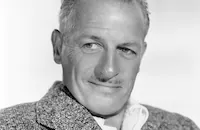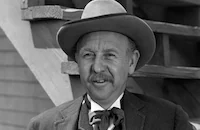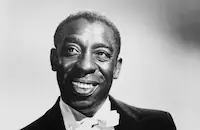My Favorite Brunette

Brief Synopsis
Cast & Crew
Elliott Nugent
Bob Hope
Dorothy Lamour
Peter Lorre
Lon Chaney [jr.]
John Hoyt
Photos & Videos
Film Details
Technical Specs

Synopsis
In San Quentin prison, baby photographer and amateur detective Ronnie Jackson, awaiting execution for murder, tells the press the story of his demise: Ever aspiring to be a detective, Ronnie invents a keyhole camera lens and buys a gun, hoping to work for private detective Sam McCloud, whose office is across from Ronnie's studio in San Francisco's Chinatown. When Sam goes to Chicago, he leaves Ronnie behind to man the telephones, and Ronnie takes the case of Carlotta Montay, a beautiful brunette whose uncle, Baron Montay, is in trouble. Carlotta is being tailed by Kismet, the henchman of Major Simon Montague, who is trying to steal the mineral rights to Montay's uranium mine in San Dimas, California. Carlotta gives the encoded map to the mines to Ronnie, and he hides it in the cup dispenser for his water cooler. He then drives to an address Carlotta gave him on the Monterey peninsula, an unoccupied mansion being used as Montague's headquarters. Montague, believing Ronnie is Sam, tells him that Carlotta is suffering from delusional tendencies, but after Ronnie takes a keyhole photograph of the wheelchair-bound baron walking, he realizes that one of Montague's men is posing as the baron, and that Carlotta is in danger. Kismet follows Ronnie to Sam's office to confiscate the photograph and knocks him out, then burns the negative. Ronnie then brings two policemen to the mansion, but they find it deserted except for Kismet, who poses as an immigrant gardener. Kismet plants a clue in Carlotta's room, which leads Ronnie to the Seacliffe Lodge, an expensive sanitarium, where he is taken hostage and held with Carlotta and the real baron. While Montague's men are away searching for the map, Ronnie and Carlotta escape. Following a tip from the baron, Ronnie and Carlotta meet James Collins, the engineer who encoded the map, and Ronnie and Collins go to the police. Outside the police station, Kismet shoots Collins dead with Ronnie's gun. Wanted for murder, Ronnie, in disguise, travels to Washington, D.C. with Carlotta in order to expose Montague, who is to meet with a representative from the State Department named Dawson. Ronnie and Carlotta pose as hotel service staff, enter Montague's suite after his meeting with Dawson and record Kismet confessing to the murder of Collins. Kismet switches the record albums, however, and Ronnie is arrested instead. In the present, Ronnie is pardoned because Sam has discovered that one of Ronnie's clients had the negative of his keyhole photograph. Now, as Carlotta and Ronnie embrace, his executioner frowns, disappointed.

Director

Elliott Nugent
Cast

Bob Hope

Dorothy Lamour

Peter Lorre

Lon Chaney [jr.]

John Hoyt

Charles Dingle

Reginald Denny

Frank Puglia

Ann Doran
Willard Robertson

Jack La Rue

Charles Arnt

Alan Ladd

Bing Crosby
Garry Owen
Richard Keene

Tony Caruso
Matt Mchugh
George Lloyd
Jack Clifford

Ray Teal
Al Hill
Eddie Johnson
Boyd Davis

Clarence Muse
Helena Phillips Evans
Roland Soo Hoo
John Westley
Charley Cooley
Jean Wong
Betty Farrington

Brandon Hurst
Jack Chefe
Barbara Freking
Tad Rand
Tom Dillon
Harland Tucker
Eddie Rio
Reginald Simpson

James Flavin
Jim Pierce
Mike P. Donovan
Budd Fine
Pauline Gaskins
Joe Recht
John Tyrell
William Newell
Crew
Edmund Beloin
Richard Blaydon
Harvey Clermont
Sam Comer
Daniel Dare
Robert Emmett Dolan
Hans Dreier
Farciot Edouart
Mel Epstein
Ray Evans
Gene Garvin
Edith Head
Earl Hedrick
Ellsworth Hoagland
Bob Hope
Bob Hope
Gordon Jennings
Harold Lewis
Lionel Lindon
Jay Livingston
John Macneil
Jack Rose
George Templeton
Wally Westmore

Photo Collections
Film Details
Technical Specs

Articles
My Favorite Brunette
The story begins as former baby photographer Ronnie Jackson (Hope), on death row for a murder he didn't commit, tells assembled reporters about his incredible misadventure. It's a perfect fish-out-of-water scenario for Hope, mistaken by Baroness Carlotta Montay (Lamour) for private detective McCloud (Ladd), who has an office next to the photo studio. Gumshoe wannabe Ronnie is not about to let on that he's not who the beautiful Carlotta thinks he is. After all, he did promise McCloud he'd keep an eye on the office. So, in his blissfully inept way, Ronnie finds himself in the middle of a complex case. Carlotta's uncle has been kidnapped by a business associate who is trying to get ownership of a valuable piece of his land. In the process of helping Miss Montay, Ronnie meets up with sinister Kismet (Peter Lorre), whom he nicknames "Cuddles"; his walnut-cracking muscle, Willie (Lon Chaney, Jr.); and a host of other great faces, including John Hoyt, Charles Dingle and Reginald Denny.
My Favorite Brunette was the first production of Hope Enterprises, Inc., and since Hope had a financial stake in the film, he apparently goofed off less than when Paramount was footing the bill. No-nonsense but good humored Lamour, a victim of Hope's off and onscreen antics in the eight films they'd done together to that point, is said to have turned the tables on her costar in this one. She apparently aped Hope's habit of chewing gum to soothe his vocal chords, even blowing a bubble just before a big screen kiss, covering them both with the mess. Still, Hope was hardly staid. As relayed in Lawrence J. Quirk's Bob Hope: The Road Well-Traveled, Bob's wife witnessed the mayhem on one of her set visits: "Dolores watched while Bob's on-set shenanigans drove Dorothy to distraction, commenting only, 'Be glad you don't have to put up with him at home too,' which Dorothy found small comfort."
My Favorite Brunette came at a time in Peter Lorre's career when roles were few and he was facing financial troubles. By many accounts, Lorre was a generous man and made a point of helping friend and stranger alike, picking up the tab even when he had to borrow to do it. Unfortunately, such kindness, joined with an inability to manage money and a lavish lifestyle, meant that he was in the red. With a continued struggle against drugs and the decline in his popularity, Brunette foreshadows the downward slide of Lorre's film roles.
Lon Chaney, Jr., who had perhaps his greatest role in Of Mice and Men (1939), had become a monster movie mainstay by the early '40s and would remain one for the rest of his career. He was reportedly bitter and felt overshadowed by his father's success. Feeling sympathetic toward the actor, Brunette director Elliott Nugent took pains to give Chaney good material and the screen time to develop it to his best advantage.
Alan Ladd isn't the film's only uncredited cameo. Bing Crosby appears to comic affect as the executioner who is disappointed when Carlotta shows up at the jail to clear Ronnie's name. Crosby also appeared as a cameo in My Favorite Blonde, further confirming for audiences that neither of the duo was ever far from the other.
Shot on location in San Francisco, My Favorite Brunette also made use of the Crocker Mansion in Pebble Beach, then owned by millionaire Paul Fagan. According to FilmMonterey.org, producers recreated the mansion's front door and used it on a soundstage where additional scenes were shot. Studio publicity of the time reported that one of Lamour's costumes in the film was a 14-karat gold gown that Edith Head made out of the last of the gold-plated cloth in Paramount's pre-war stock.
Producer: Daniel Dare
Director: Elliott Nugent
Screenplay: Edmund Beloin, Jack Rose
Cinematography: Lionel Lindon
Art Direction: Hans Dreier, Earl Hedrick
Music: Robert Emmett Dolan
Film Editing: Ellsworth Hoagland
Cast: Bob Hope (Ronnie Jackson), Dorothy Lamour (Baroness Carlotta Montay), Peter Lorre (Kismet), John Hoyt (Dr. Lundau), Charles Dingle (Major Simon Montague), Reginald Denny (James Collins), Frank Puglia (Baron Stefan Montay/Nicholas), Ann Doran (Miss Rogers), Willard Robertson (prison warden), Jack La Rue (Tony).
BW-86m.
by Emily Soares

My Favorite Brunette
Quotes
Uh oh, her schizo's about to phrenia!- Ronnie Jackson
You see, I wanted to be a detective too. It only took brains, courage, and a gun...and I had the gun.- Ronnie Jackson
I'm at my wit's end!- Carlotta Montay
I passed there an hour ago.- Ronnie Jackson
Trivia
Notes
Bob Hope and Dorothy Lamour's screen credits appear on a florist's greeting card which reads: "From Bob Hope to Dorothy Lamour." This film was the first production of Hope Enterprises, Inc. It was a sequel, in name only, to Hope's 1942 film My Favorite Blonde, which was this film's working title, in addition to The Private Eye. The film satirizes The Maltese Falcon, among other detective films. Alan Ladd makes a cameo appearance as a Detective Sam McCloud. Bing Crosby, who appeared throughout the 40s in the "Road to..." pictures as a friendly antagonist to Bob Hope, made an uncredited cameo appearance at the end of the film as Hope's would-be executioner. For more information on the "Road to..." pictures, in which Lamour also starred, consult the Series Index. My Favorite Brunette was Lamour's thirty-fifth picture, and during production, she celebrated her tenth anniversary at Paramount. The film marked Lon Chaney's first after leaving Universal Pictures. According to the Par News, the film includes shots of the one-million-dollar Paul Fagan mansion at Carmel, CA, on the Monterey Peninsula. Location shooting was also done in San Francisco, CA. According to a Hollywood Reporter news item, the gas chamber and condemned row at San Quentin prison were recreated for the execution scene. According to Par News, in the film, Lamour wears a 14-karat gold dress which costumer Edith Head made out of the last of the gold-plated cloth in the Paramount studio's pre-war stock.

Miscellaneous Notes
Released in United States Spring April 4, 1947
Released in United States Spring April 4, 1947













